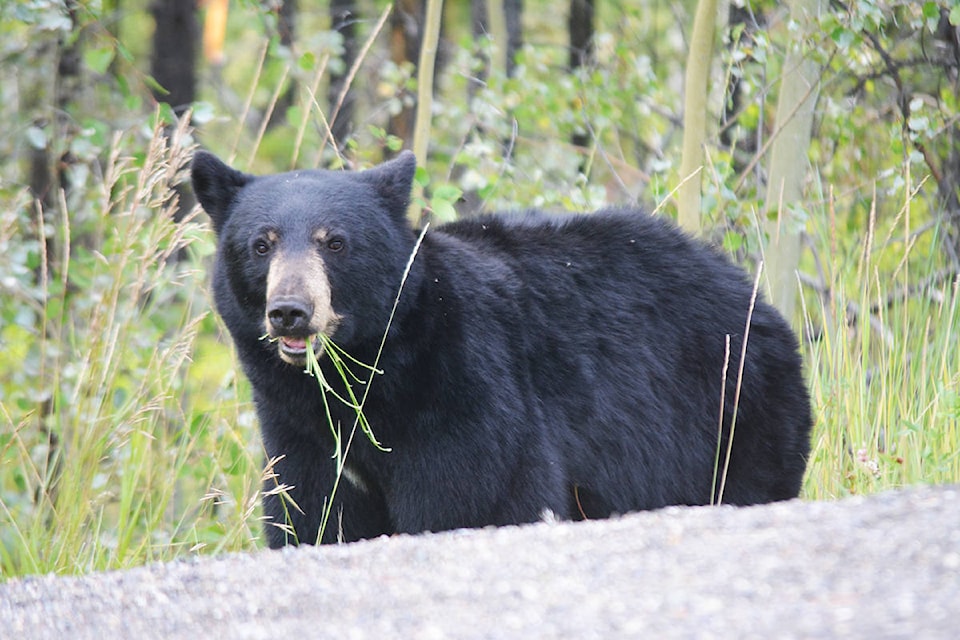As bears begin to come out of hibernation, the Province is encouraging homeowners to ensure that they are securing bear attractants such as garbage and recycling, especially during this time of social distancing where more household waste may be being produced.
“If bears do not have access to non-natural food sources, such as garbage, fruit and bird seed within communities, they have no reason to hang around. This results in increased safety for both people and bears,” Mike Badry, provincial wildlife conflict manager with the B.C. Conservation Officer Service, said in an April 17 news release. “Residents could turn this unusual time into something positive for wildlife by taking extra time to secure attractants and educate themselves about Bear Smart practices.”
According to the British Columbia Conservation Foundation, B.C. is home to approximately 120,000 to 150,000 black bears — one of the highest populations of the animal in the world — as well as approximately 15,000 grizzly bears, which makes up about a quarter of North America’s population.
As bears begin to shake off their winter slumber and make their way out of their dens, food is the first thing on their minds, says provincial WildSafeBC co-ordinator Vanessa Isnardy.
“Bears are starting to come out now; usually it’s the males first out of their den, then it’s the sow females with the cubs, and they’re looking for lush fresh green growth — that’s what is going to get their digestive system going,” she said. “They have probably lost up to 30 per cent of their body weight over the winter, and now they’re coming out and they are trying to replenish their stores. So they’ll start off easy, looking for lush greens, then they’ll also take advantage of any winter kill, so if people see a carcass in an area, it’s really important to leave that area immediately and notify the Conservation Officer Service or the property owner and let them know of that because it could attract scavengers and predators to that winter kill.”
With many bear populations in the province living in close proximity to human populations, human and bear conflicts are inevitable, but many can and should be avoided for the safety of individuals, as well as the animals, says Isnardy.
“The biggest concern is that we don’t want bears to be drawn into our communities seeking out food rewards from garbage that has been left out unsecured,” she said. “It’s really important now that the bears are up to make sure that we are keeping our garbage secure inside a building or a structure if possible to make sure the bears aren’t able to access it. The most important thing is not to put your garbage out the night before collection — always do it on the morning of. Bears tend to come into communities at night when there is less human activity, and that is when they might find a food reward, which will lead to potential conflict and could end poorly for that bear and also be a safety concern for the community.”
In 2019, the Conservation Officer Service received more than 20,000 calls regarding conflicts with bears, and due to these conflicts, a total of 657 black bears and 36 grizzly bears were destroyed, while 11 black bears were translocated.
Isnardy says that the difficulty with relocating bears is that not only is the process very hard on the animal, but once they are moved to a new area, they are unfamiliar with where the food sources are and often will travel long distances to return to where they were captured. Instead, Isnardy believes the best way to avoid unnecessary bear deaths is to ensure their conflict with humans doesn’t happen in the first place.
“The trick is to get to the root source and the cause of the conflict to begin with, and bears are naturally wary and afraid of people,” said Isnardy. “The trick is not teaching bears that being around people leads to a food reward. If we can avoid teaching them that, then they will tend to avoid us.”
Isnardy says aside from ensuring their garbage is secure from bears, residents should also be aware of other bear attractants, such as fruit trees, poultry and bird feeders.
“It’s really important to not let them have access to any food that they get energy and calories from, and that includes fruit trees, it might include poultry that’s unsecured with an electric fence, and that also includes bird feeders,” said Isnardy. “There is 8,000 calories in one kilogram of bird seed, so now is a good time to take down those bird feeders — there’s lots of natural food for birds now. If people want to observe birds, consider installing a bird house or maybe a bird bath, but bird seed is a strong attractant for bears.”
Anyone interested in learning more about the resources offered by WildsafeBC can visit wildsafebc.com. Individuals needing advice or wishing to report an immediate conflict with wildlife are encouraged to contact the B.C. Conservation Officer Service at 1-877-952-7277.
READ MORE: Quesnel boys help rescue bear cub
editor@quesnelobserver.com
Like us on Facebook and follow us on Twitter
